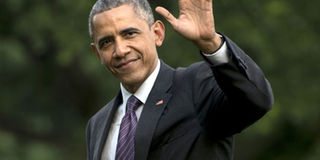Obama’s Africa visit to highlight his legacy projects for continent

US President Barack Obama waves to crowds at the White House in Washington, DC, last week upon his return from Nashville, Tennessee. PHOTO BY AFP
NAIROBI- US President Barack Obama arrives in the land of his father, Kenya, this month in a confident and optimistic mood after a series of political victories at home and the American economy showing increasing strength.
President Obama, whose term ends in 18 months, will also be focused on his legacy, which includes three Africa-focused endeavours: Feed the Future (FtF), Trade Africa and Power Africa.
The president is likely to tout these initiatives as major achievements though sceptics suggest that it is premature to declare at least the trade and energy programmes successful.
They say it remains to be seen whether the first African-American US president will leave as concretely beneficial a legacy in Africa as did his predecessor.
George W Bush’s Aids relief effort and the conditioned development-assistance grants known as the Millennium Challenge Account are widely seen as far-reaching and enduring accomplishments.
President Obama may therefore also be feeling defensive as he extols his Africa trade, electricity and food programmes, each of which includes Kenya and Tanzania as targeted beneficiaries.
What critics say
Critics charge that President Obama has been slow in setting an agenda that may have the potential to help Africa as much as Mr Bush’s programmes already have.
FtF, however, is not a newly minted innovation. Launched in 2010, it is the most established of the three initiatives by President Obama. It thus has a record and at least some analysts regard it as positive.
A recent appraisal by the British NGO Oxfam said, “There is no doubt FtF has demonstrated substantial, real and important improvements in the way the US Agency for International Development (Usaid), delivers assistance.”
Oxfam cited some ways in which the programme can be made more effective. But, overall, the anti-poverty group found that FtF is “helping to ensure greater country ownership of US investments” while seeking to empower female farmers.
Kenya, Rwanda, Tanzania and Uganda are among the 20 countries targeted for agricultural sector enhancements through FtF. In addition to promoting better inputs — such as fertilisers, seeds and animal vaccines — the programme seeks to facilitate greater efficiencies in storage and transport of crops while also helping more farmers qualify for loans. FtF further aims at improving nutrition, especially for women and children.
Power Africa ranks as the most ambitious of President Obama’s attempts at spurring transformational change in the sub-Saharan region.
The president pledged in a speech two years ago in Cape Town that this initiative will produce a doubling of access to electricity in Africa within five years.
That’s an enormously ambitious goal, and it was established in the context of numerous failed attempts by African leaders to bring electricity to millions of homes.
If Power Africa does hit its target, it is likely to be seen by history as having had a revolutionary effect.
Tom Hart, director of the US chapter of the global anti-poverty campaign initiated by rock star Bono, sees Power Africa as a complement to the Africa Growth and Opportunity Act (Agoa).
That trade preference programme — a Bill Clinton legacy — cannot succeed in vastly increasing African exports to the US unless the continent has energy resources sufficient to allow factories to produce more goods, Mr Hart observes.
Too ambitious?
Power Africa, which is initially focused on Kenya, Tanzania and four other sub-Saharan countries, involves what its architects say is a $36 billion commitment on the part of Washington, US private businesses, the World Bank, African Development Bank and Sweden.
Only a small portion of the funding takes the form of grants or direct aid to energy projects. Power Africa instead relies on US government loan guarantees and multilateral financial institutions’ related inducements to spur massive private investment in electricity generation in Africa.
Its administrators say 80 US businesses have committed $20 billion in financing for Power Africa. That has led some critics to suggest that Power Africa is as much an effort to create opportunities for US corporations as it is to light homes on the continent.
It is also unclear how much of that promised capital has been provided and it remains to be seen whether Power Africa’s $7 billion US government financing component will remain post-Obama.
Projects started by Obama in Africa
Feed the Future : This project targets agricultural sector enhancements through promoting better inputs such as fertilisers, seeds and animal vaccines. the programme seeks to facilitate greater efficiencies in storage and transport of crops while also helping more farmers qualify for loans.
Trade Africa: Trade Africa is a partnership between the United States and sub-Saharan Africa to increase internal and regional trade within Africa, and expand trade and economic ties among Africa, the United States, and other global markets.
Power Africa: Power Africa relies on US government loan guarantees and multilateral financial institutions’ related inducements to spur massive private investment in electricity generation in Africa




